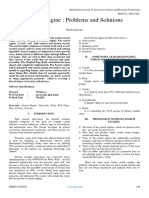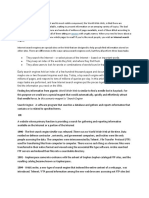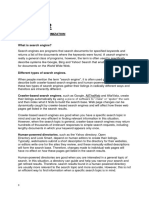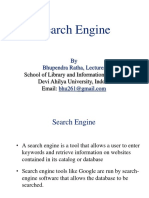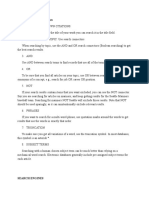0 ratings0% found this document useful (0 votes) 28 views9 pagesAs3 DM
Copyright
© © All Rights Reserved
We take content rights seriously. If you suspect this is your content,
claim it here.
Available Formats
Download as PDF or read online on Scribd
ASSIGNMENT 3
DIGITAL MARKETING
1) Explain about search engine working process?
AIS. Search engines are powerful tools designed to quickly locate relevant information
from the vast data available on the internet. They work thaugh three main processes:
craveling, indexing, and ranking, Here's an overview of each step in the process:
1. Crawling
Crawling is the initial step where search engines discover new or updated content oa the web.
This is dane through web crawlers (also called spiders or bets), which are automated
Programs that navigate through links on websites. to gather data, Here's how crawling works:
* Starting Points: Crawlers begin with a list af known web pages, such as popular
websites or previously indexed pages,
* Following Links: Crawlers follaw hyperlinks from these starting pages to discover
‘new content. This allows them to reach vasi amounts of web pages over time.
* Updating [nformation: If a page has been updated since the Last visit, the crawler
notes the changes, ensuring that the search engine has the most current information.
(Crawling is selective; nat all web pages are crawled, and some are crawled more frequently,
especially if they're popular or frequently updated,
2. Indexing,
‘Once a crawler gathers information, it moves to the indexing stage. Indexing organizes and
stores the data in a structured way, so the search engine can quickly retrieve it when a user
submits a query. The indexing process includes:
= Analyzing Content: The search engine analyzes the page's text, images, metadata
(like title and description), and even the context af keywords.
© Organizing Data: Data is stored in an index, a massive database of all the words,
topics, and links discovered by the crawlers. This index allows for fast lookups during
a search
+ Assigning Keywords: Each page is associated with certain keywords and topics
based on the contest, which helps the search engine understand what the page is
about.�3. Ranking,
When a user submits a query, the search engine sorts through the indexed data to present the
‘mast relevant results. This process is called ranking and involves:
= Algorithms: Search engines use complex algorithms to evaluate pages and rank them
based on relevance, quality, and user experience. Factors include keyword matching.
page quality, freshness, and user engagement.
+ Relevance Scoring: Pages are scored based on how well they match the user's query.
For example, poges that contain the exact keywords are ranked higher than thase
without,
+ User Signals: User behavior, such as click-through rate (CTR) and time spent on a
page, can also influence ranking aver time,
Additional Elements in Modern Search Engines
Modern search engines use advanced techniques to imprave accuracy and relevance:
+ Natural Language Processing (NLP): NLP helps search engines understand search
intent and context, making them better at handiing complex or ambiguous queries.
+ Personalization: Search engines may personalize results bases! on a user's past search
history, location, and preferences,
+ Machine Learning: Algorithms now learn and improve aver time by analyzing vast
amounts of data, leading to increasingly accurate search results.
‘These theee primary steps—crawling, indexing, and raaking—allow search engines to
respond in milliseconds, delivering highly relevant results for users across the glabe,
2) Write about major search engines?
Ans, Several major search engines dominate the market, each with unique features and
search algorithms. Here's an overview of some of the most widely used search engines:
1. Google
Market Share: Over 9% globally.
Google is the most papular and widely used search engine. Known for its powerful
algorithms and constant innovation, Google focuses on providing highly relevant search
results, Key features include:
+ PageRank Algorithm: Initially, Google's PageRank algorithm set it apart by�evaluating the quality of backlinks to assess the authority and relevance of pages.
+ Advanced Algorithms: Google continuously updates its search algorithms (Like
Panda, Penguin, Hummingbird, and BERT) to impsave the relevance, quality, and
accuracy of search results.
* Rich Snippets & Knowledge Graph: Google often displays rich snippets (0.g.,
answers, recipes, or reviews) and knowledge panels ta provide quick answers and
additional context.
» Personalization: Google personalizes search results based on factors like search
history, location, and preferences,
= Wide Ecosystem: Integrated with services like Google Maps, Gmail, YouTube, and
Google Shopping, it offers a comprehensive user experience.
2. Bing
Market Share: Around 2-2%.
Microsoft's Bing is the second mast popular search engine, and it serves as the default engine
for Microsoft's products, such as Windows and Edge, Bing’s features include:
# Image and Video Search: Known for a rich image and vidleo search experience, Bing
provides high-quality previews and filters,
* Visual Search: Bing allows users to search using images rather than text, enhancing
search capabilities,
+ Rewards Program: Microsoft Rewards offers points for Bing searches, which can be
redeemed for gift cards or donations,
+ Integration with Microsoft Products: Bing integrates with tools like Office,
Outlook, and Cortana, providing a smooth experience for Microsoft users.
3. Yahoo
Market Share: Around 1-2%.
‘Yahoo was one of the earliest search engines and remains popular in specific regions,
(Currently powered by Bing’s search technology, Yahoo offers:
= Comprehensive Portal; Yahoo acts as a full-fledged web portal with email, news,
finance, sports, and lifestyle sections,
= News Aggregation: Yahoo's new’ and finance sections are widely used for
aggregated content, especially in the United States.
© Email Service: Yahoo Mail is one of the world’s most used email platforms,
contributing to Yahoo's ecosystem.
4. Baidu
Market Share: Dominant in China.
‘Baidu is China’s leading search engine, serving as the primary choice for the Chinese market
due ta strict regulations on international search engines. Key fearures include:
+ Language and Cultural Relevance: Baidu focuses on Mandarin language content,�making it well-suited ta local users.
© Search & Ecosystem Integration: Baidu has. its own suite of services, including
‘maps, news, cloud storage, and more, similar to Gangle's ecosystem.
+ Aland Autonomous Driving: Baidu invests in Al and autonomous driving
technologies, expanding its influence beyond search,
5. Yandex
Market Share: Popular in Russia and CIS countries.
‘Yandex is Russia’s leading search engine and also operates in neighboring countries. It offers
many services, such as email, maps, and a browser. Key features include:
+ Language and Local Preferences: Yandex is designed to hardle the complexities of
Russian language and culture effectively.
* Extensive Ecosystem: Yandex provides variows tools and services, like Yandex.Mail,
‘Yandex. Maps, Yandex. Market (for shopping), and ‘Yandex, Taxi (ride-hoiling).
* Machine Learning: Yandex uses Al and machine learning to imprave its ranking,
algorithms, similar to Google.
6. DuckDuckGo
Market Share: Growing, but under 1%.
uckDuckGo is a privacy-focused search engine that has gained popularity among users
concerned about data privacy. Its main features include:
+ No Tracking: DuckDuckGo does not track users or store personal information,
making it appealing for privacy-conscious users.
* Anonymous Search; DuckDuckGo provides unpersonalized search results, which is a
unique approach compared to other search engines.
+ Instant Answers: Similar to Google’s rich snippets, DuckDuckGo provides instant
answers fram trusted sources,
7. Ecosia
Market Share: Snall but growing,
Ecosia is a socially conscious search engine based in Germany that donates a large portion of
its revenue to tree-planting initiatives. Key features include:
+ Environmentally Friendly: Ecosia planes tees with its ad revenue, and the company
is known far its transparency and environmental impact.
+ Privacy-Friendly: Ecosia does not sell user data to advertisers, and it enonymixes
searches after a certain period,
Summary
Each search engine has carved out its niche, whether through privacy (DuckDuckGo),�environmental impact (Ecosia), regional dominance (Baidu, Yandex), or extensive
ecosystems (Google, Bing).
3) What are the components of search engine?
ANS. A search engine is a complex system that comprises several care components, Each
plays a unique role in finding, organizing, and presenting retevant information ta users. Flere
are the main components of a search engine:
1. Web Crawler (Spider or Bot)
© Purpose; The web crawler is an automated program that “crawls” the web,
discovering new and updated content, It starts. with a set of known URLs and follows
links an each page to discover additional pages.
© Functionality: Crawlers help ensure the search engine stays updated by regularly
revisiting pages and recording changes,
= Types: Search engines often have multiple crawlers for different purposes, stich as
specific crawlers for images, video, or mobile content.
2. Index
© Purpese: The index is a massive database where the search engine stores information
about each web page it has crawled, This is essentially the “Library” of the search
= Funetionality: The index contains keywords, metadata, page content, links, and other
relevant data. It is optimized for quick retrieval to provide fast results.
* Structure: The index organizes content to allow for efficient keyword searching, It
may use data structures like inverted indexes, which associate keywords with lists of
web pages,
3. Ranking Algorithm:
* Purpose: The ranking algorithm determines the order in which search results are
presented to users. It evaluates the relevance, quality, and authority of each page in
relation to a search query.
+ Functionality: The algorithm considers factors such as keyword match, content
quality, page authority, and user experience to rank pages. Google’s PageRank. for
instance, considers the quality and quantity of links pointing to a page aa measure of
authority.
+ Machine Learning: Modern ranking algorithms incorporate machine learning to
refine results based on user feedback, search intent, and context.
4. Query Processor
Purpose: The query processor interprets the user's search query and prepares it for
matching with the index. It belps the search engine understand the intent behind the
query and deliver moce relevant results,
+ Functionality: The query processor analyzes keywords, remaves siop words (like
“and” oc “the"), and may apply stemming (reducing wards to their root farms, e.g,�running” to “run”.
+ Natural Language Processing (NLP): Many search engines use NLP techniques to
better understand complex queries, questions, and conversational Language
5. User Interface (UI)
* Purpose: The Ul is what users interact with when using the search engine. It inclucles
the search bar, filters, search result page, and other visual elements.
+ Functionality: The Ulis designed to be simple and intuitive, enabling users to search
and view results efficiently, Advanced features include filters, sort options, and
previews.
+ Enhanced Elements: UI may also include instant answers, knowledge panels, rich
snippets, and featured results, providing, users with information directly on the search
pape.
6. Data Center & Server Infrastructure
«© Purpose; Search engines rely on data centers and server infrastructure to store
massive amounts of data, handle high traffic volumes, and provide fast, reliable
results.
* Functionality: Servers process user queries, manage the Indexing process, and deliver
results with minimal latency. Data centers must be capable of handling the storage and
processing needs of large search engines like Google.
+ Redundancy and Scalability: Data centers are typically distributed globally to
ensure quick access and redundancy, allowing search engines to continue functioning,
even If one data center Fails,
7. SEO and Ranking Signals (Quality and Relevance Assessment)
= Purpose: Search engines use a vartety of signals to assess the quality and relevance of
‘web pages, such as backlinks, user engagement, content freshness, and mabile
‘usability.
«= Functionality: These ranking signals are part of what the ranking algorithm uses to-
score and rank pages. Google's E-A-T criteria (Expertise, Authority, and
‘Trustworthiness) is an example of quality assessment that ensures high-quality
‘content is prioritized.
«User Feedback: Some search engines incorporate user feedback, click-through rates,
and bounce rates to continuously refine their relevance assessments.
8. Ad System
+ Purpose: Search engines generate revenue through advertising platforms that display
ads based on keywords and user intent.
+ Functionality: Ad systems, like Google Ads, allow businesses to bid an keywards to
display targeted ads at the top of search results. Ads are usually marked as sponsored
and operate on a pay-per-click (PPC) model
+ Targeting and Personalization: Ads are often tailored to users based on factors such
as their location, browsing history, and demographics.�Summary of Components and Their Roles:
‘These components work together seamlessly to ensure users receive fast, accurate, and
relevant search results, Here's a quick overview:
1. Web Crawler ~ Discowors and retrieves web contest.
2. Index ~ Stores and organizes content for efficient retrieval.
3. Ranking Algorithm ~ Scores and ranks pages by relevance.
4. Query Processor ~ Interprets and processes user queries.
5. User Interface — Provides an accessible, user-friendly platform,
6. Data Center ~ Ensures data storage and quick retrieval,
7. Ranking Signals — Assesses quality and relevance for ranking.
8. Ad System ~ Provides targeted advertising for revenue.
‘Together, these components create a robust system that enables search engines to manage
enormous amounts of data, handle millions of queries, and deliver useful information in
seconds.
4) Write about processing and indexing in search engine?
ANS. Processing and indexing are twa critical functions in a search engine’s workflow that
allow it to find and retrieve relevant information quickly. Here's an overview of each process:
1. Processing
Processing is the initial step in handling a user's query. I involves breaking down and
preparing the query to make it understandable for the search engine. Here's a closer look at
how processing works:
Key Steps in Processing:
* Query Parsing: The search engine's query processor analyzes the structure of the
search query to understand its intent, This involves identifying keywords, recognizing,
‘common phrases, and breaking the query into essential parts.
* Removing Stop Words: Many search engines filter out commen words that don’t
‘contribute to meaning, such as “and,” “the,” “of,” and “in.” Removing these "stop
words” improves processing efficiency without affecting relevance.
+ Stemming and Lemmatization: The processor applies linguistic techniques like
stemming (reducing words to their root form, e.g. “running” vo "run”) andl
Jemmatization (reducing words to their dictionary form, e.g. "beter" to " goad") to
simplify queries and improve search relevance.
+ Synonym Matching: Many search engines use synonym matching to understand
different variations of the same woe, For instance, if a user searches for "ear repair,”
the search engine may also consider "auto repair" in the results.
+ Natural Language Processing (NLP); Advanced search engines, like Gongle, use
NLP to handle complex or conversational queries. NLP helps recognize search intent,
enabling better responses for questions and long-tail queries.�Importance of Processing:
Processing allows the search engine to understand and interpret user queries accurately,
enhancing the relevance of the results. By refining the query, the search engine can deliver
botter answers that align more closely with what the user is looking for.
2. Indexing,
Indexing is the process of organizing and storing information gathered from web pages s0
that it can be efficiently retrieved. After crawling web pages, the search engine extracts
relevant information and builds a structured index, similar to a library catalog, that it can
quickly search thraugh when a query is submitted.
Key Steps in Indexing:
‘Content Extraction: After « page is crawled, the search engine extracts key data from
it, including:
9 Keywords: The words and phrases on the page.
© Metadata: Title togs, descriptions, and keywords defined in the ETTMI. meta
tags,
© Links: Both internal (links within the same site) and extemal (links to other
sites), which provide context and authority signals,
© Media: Images, videos, and other media elements are nated for specific
searches.
Storing and Structuring Data: The extracted data is stored in an index—a massive
database that catalogs information in a way that makes it easy for the search engine to
retrieve, This index uses:
o Inverted Index: This is a core structure in search engines. Instead of mapping
pages to keywords, an inverted index maps keywords to pages, allowing Ue
search engine ta find all relevant pages for a given keyword quickly.
© Document IDs: Each indexed page is assigned a unique document ID, which
links all associated keywords and metadata to that page
Assigning Relevance Signals; During indexing, search engines assess each page’s
‘quality and relevance, Factors may include:
o Page Autherity; Based on backlinks and the overall reputatian of the site.
© Content Quality: Including keyword relevance, originality, readability, and
accuracy.
© User Engagement; Some search engines track engagement metrics like click-
through rate (CTR) and time spent on a page.
0 Freshness: Newer content may be prioritized for queries where recent
information is valuable.
Indexing for Different Coment Types; Search engines also maintain indexes for
different types of content, such as text, images, videos, and even real-time data,
allowing for multimedia search capabilities.
Importance of Indexing:�Indexing allows the search engine to store and organize the wast amount of data it collects
efficiently. By having an onganized, structured index, the search engine can quickly retrieve
relevant resulis whem users perform searches. This structure is what enables fast, accurate,
and scalable searches even with billions of web pages to sift through.
‘Summary
In essence, processing prepares and interprets the query to ensure accurate understanding,
while indexing organizes and structures the data from web pages to enable fast retrieval.
“Together, these functions make it possible for search engines ta pravide relevant search
results within milliseconds.
‘+ Processing: Interprets and prepares the user’s query.
Indexing: Organizes data into a structured database for efficient search and retrieval.























